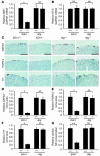Endothelin-1 regulates cardiac sympathetic innervation in the rodent heart by controlling nerve growth factor expression
- PMID: 15067320
- PMCID: PMC362115
- DOI: 10.1172/JCI19480
Endothelin-1 regulates cardiac sympathetic innervation in the rodent heart by controlling nerve growth factor expression
Abstract
The cardiac sympathetic nerve plays an important role in regulating cardiac function, and nerve growth factor (NGF) contributes to its development and maintenance. However, little is known about the molecular mechanisms that regulate NGF expression and sympathetic innervation of the heart. In an effort to identify regulators of NGF in cardiomyocytes, we found that endothelin-1 specifically upregulated NGF expression in primary cultured cardiomyocytes. Endothelin-1-induced NGF augmentation was mediated by the endothelin-A receptor, Gibetagamma, PKC, the Src family, EGFR, extracellular signal-regulated kinase, p38MAPK, activator protein-1, and the CCAAT/enhancer-binding protein delta element. Either conditioned medium or coculture with endothelin-1-stimulated cardiomyocytes caused NGF-mediated PC12 cell differentiation. NGF expression, cardiac sympathetic innervation, and norepinephrine concentration were specifically reduced in endothelin-1-deficient mouse hearts, but not in angiotensinogen-deficient mice. In endothelin-1-deficient mice the sympathetic stellate ganglia exhibited excess apoptosis and displayed loss of neurons at the late embryonic stage. Furthermore, cardiac-specific overexpression of NGF in endothelin-1-deficient mice overcame the reduced sympathetic innervation and loss of stellate ganglia neurons. These findings indicate that endothelin-1 regulates NGF expression in cardiomyocytes and plays a critical role in sympathetic innervation of the heart.
Figures






Comment in
-
Sculpting organ innervation.J Clin Invest. 2004 Mar;113(6):811-3. doi: 10.1172/JCI21309. J Clin Invest. 2004. PMID: 15067313 Free PMC article.
Similar articles
-
Regulation of nerve growth factor in the heart: the role of the calcineurin-NFAT pathway.J Mol Cell Cardiol. 2009 Apr;46(4):568-78. doi: 10.1016/j.yjmcc.2008.12.006. Epub 2008 Dec 25. J Mol Cell Cardiol. 2009. PMID: 19150448
-
Electrical stimulation of sympathetic neurons induces autocrine/paracrine effects of NGF mediated by TrkA.J Mol Cell Cardiol. 2010 Jul;49(1):79-87. doi: 10.1016/j.yjmcc.2010.01.019. Epub 2010 Feb 2. J Mol Cell Cardiol. 2010. PMID: 20138055
-
Nerve growth factor collaborates with myocyte-derived factors to promote development of presynaptic sites in cultured sympathetic neurons.J Neurobiol. 2000 Mar;42(4):460-76. J Neurobiol. 2000. PMID: 10699983
-
New aspects for the treatment of cardiac diseases based on the diversity of functional controls on cardiac muscles: the regulatory mechanisms of cardiac innervation and their critical roles in cardiac performance.J Pharmacol Sci. 2009 Mar;109(3):348-53. doi: 10.1254/jphs.08r25fm. Epub 2009 Mar 7. J Pharmacol Sci. 2009. PMID: 19270423 Review.
-
Development, maturation, and transdifferentiation of cardiac sympathetic nerves.Circ Res. 2012 Jan 20;110(2):325-36. doi: 10.1161/CIRCRESAHA.111.257253. Circ Res. 2012. PMID: 22267838 Review.
Cited by
-
Coronary veins determine the pattern of sympathetic innervation in the developing heart.Development. 2013 Apr;140(7):1475-85. doi: 10.1242/dev.087601. Epub 2013 Mar 5. Development. 2013. PMID: 23462468 Free PMC article.
-
Endothelin and the Cardiovascular System: The Long Journey and Where We Are Going.Biology (Basel). 2022 May 16;11(5):759. doi: 10.3390/biology11050759. Biology (Basel). 2022. PMID: 35625487 Free PMC article. Review.
-
Integrative approaches in cardiac tissue engineering: Bridging cellular complexity to create accurate physiological models.iScience. 2025 Jun 25;28(8):113003. doi: 10.1016/j.isci.2025.113003. eCollection 2025 Aug 15. iScience. 2025. PMID: 40697825 Free PMC article. Review.
-
Axon guidance molecules in vascular patterning.Cold Spring Harb Perspect Biol. 2010 May;2(5):a001875. doi: 10.1101/cshperspect.a001875. Epub 2010 Mar 31. Cold Spring Harb Perspect Biol. 2010. PMID: 20452960 Free PMC article. Review.
-
Electroacupuncture pretreatment mediates sympathetic nerves to alleviate myocardial ischemia-reperfusion injury via CRH neurons in the paraventricular nucleus of the hypothalamus.Chin Med. 2024 Mar 6;19(1):43. doi: 10.1186/s13020-024-00916-y. Chin Med. 2024. PMID: 38448912 Free PMC article.
References
-
- Loring JF, Erickson CA. Neural crest cell migratory pathways in the trunk of the chick embryo. Dev. Biol. 1987;121:220–236. - PubMed
-
- Snider WD. Functions of the neurotrophins during nervous system development: what the knockouts are teaching us. Cell. 1994;77:627–638. - PubMed
-
- Brennan C, Rivas-Plata K, Landis SC. The p75 neurotrophin receptor influences NT-3 responsiveness of sympathetic neurons in vivo. Nat. Neurosci. 1999;2:699–705. - PubMed
Publication types
MeSH terms
Substances
LinkOut - more resources
Full Text Sources
Other Literature Sources
Molecular Biology Databases
Research Materials
Miscellaneous

